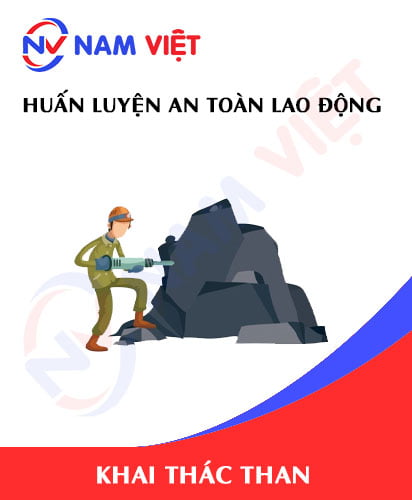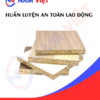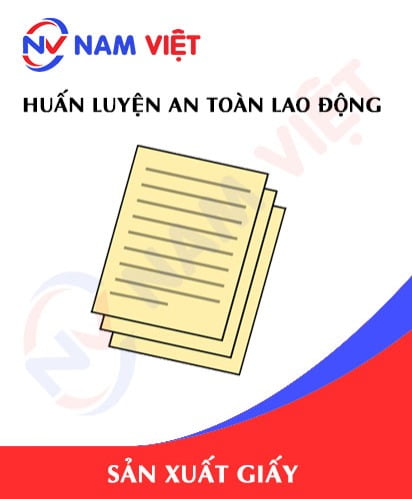Occupational Safety Training in Coal Mining
99,000 ₫
Note: The above price is calculated for one person, the price may fluctuate depending on the number of trainees participating in the course and the movement of the market. For more accurate pricing support, please refer to the quotation table or contact our consulting staff directly.
Occupational safety is an important issue in coal mining sites and needs to be addressed promptly to ensure the health and safety of workers and enhance the reputation of enterprises. The Occupational Safety Training course is one of the effective solutions to raise awareness about preventing occupational accidents for workers when participating in coal mining.
Table of Contents
Toggle1. Overview of Coal Mining
a. What is Coal?
- A charcoal mine is a site for excavating black earth to obtain charcoal from wood blocks or some other types of natural coal. The charcoal manufacturing process begins by placing wood blocks or other natural materials in a boiler where they are burned in an atmosphere with little or no oxygen, thereby producing charcoal. This process usually takes place in an underground tunnel, and excavating charcoal from a charcoal mine requires special techniques and equipment to ensure worker safety and environmental protection.
- Currently, Vietnam still mines coal to provide energy for manufacturing and daily life, but this industry is gradually shifting to mining newer types of coal such as lignite, gasified coal, and peat. At the same time, the Vietnamese government is encouraging investment in renewable energy sources such as wind power, solar power, and hydropower to reduce dependence on coal and reduce polluting emissions.
- However, coal mining still faces many challenges such as toxic emissions that cause environmental pollution and affect the health of the public, occupational accidents during the coal mining process, and the gradual decrease in high-quality coal sources. Therefore, it is necessary to have innovative solutions and continued investment to develop alternative energy sources, protect the environment, and improve the working conditions of workers in the coal mining industry.

b. Types of Coal Mining Machinery
There are many types of machinery and equipment used in the coal mining industry to make the mining process more efficient and safer. Some common types of machinery and equipment in the coal mining industry include:
- Excavator: Used to excavate earth and retrieve coal from underground coal mines.
- Bulldozer: Used to move earth and dump it to create tunnels in the coal mine.
- Crusher: Used to crush large coal blocks into smaller, more convenient blocks for transportation.
- Tractor: Used to tow trucks or other equipment to transport coal and other materials to their destinations.
- Coal truck: Used to transport coal from the coal mine to other coal-consuming units.
- Conveyor system: Used to transport coal from the coal mine to other facilities such as ships, bus stations, power plants, etc.
- Dust collector: Used to collect coal dust and emissions during the mining process to ensure a safe working environment for workers.
These types of machinery and equipment play an important role in making the coal mining process more efficient and safer. However, it is necessary to comply with safety regulations, procedures, and guidelines on the use of machinery and equipment to ensure safety and environmental protection.

c. Typical Coal Mining Enterprises in Vietnam
In Vietnam, the coal mining industry has been developed for a long time and there are many enterprises operating in this field. The following are some typical coal mining enterprises in Vietnam:
- Vinacomin Coal – Mineral Joint Stock Corporation: The largest enterprise in the coal mining industry in Vietnam. Vinacomin manages and operates a series of coal mines nationwide, contributing significantly to the country’s manufacturing and economic development.
- TKV Coal and Mineral Group: TKV is the second largest coal mining group in Vietnam, with many large coal mines and an annual output of millions of tons.
- Mao Khe Coal Group: A large coal mining enterprise in Quang Ninh, with the Mao Khe coal mine being the largest coal mine in this locality.
- Ha Tu Coal Joint Stock Company: A coal mining enterprise in Quang Ninh province, with an annual output of hundreds of thousands of tons.
- Khe Cham Coal Joint Stock Company: A coal mining enterprise in Quang Ninh province, with the Khe Cham coal mine being the largest coal mine in this locality.
In addition, there are many other coal mining enterprises such as Bao Thang Coal Joint Stock Company, Bao Minh Coal Joint Stock Company, Tan Cang – Cam Pha Coal Joint Stock Company, etc. Among them, Vinacomin and TKV are the two largest and most important enterprises in the coal mining industry in Vietnam.
d. Specific Jobs in a Coal Mine
Group 1
- Executive director, deputy executive director of the coal mining company.
Group 2
- Safety officer: manages safety in the mine, designs safety procedures, supervises and urges employees to comply with safe work procedures.
Group 3
- Training and equipment operation training: This is an important job to ensure that employees and workers have enough knowledge and skills to operate coal mining equipment safely and effectively.
- Coal mining: This job includes using machinery to excavate earth and push it out of the mine, then taking coal from the earth layers and bringing it out.
- Coal transportation: This job includes moving coal from the mine to the storage or processing area. This can be done by using trucks, specialized vehicles, and other transportation means.
- Equipment repair and maintenance: Equipment repair and maintenance staff have the task of ensuring that coal mining equipment always operates effectively and safely.
- Quality control: This job includes supervising the manufacturing process to ensure that the coal is manufactured with the right quality and meets safety and environmental standards.
- Environmental management: This job includes supervising and ensuring that the coal mining process does not cause environmental pollution and meets environmental protection standards.
- Human resource management: This job includes managing and supervising employees and workers in the mine to ensure that the work is done correctly and meets safety and efficiency standards.
Group 4
- Office work, service, sales, marketing.
- Financial accounting management.
- Research and development of coal mining technology.

2. Overview of the occupational safety training course for coal mining
Within the scope of this article, we focus on issues related to Group 3, because Group 3 is the group that directly participates in the manufacturing process and is exposed to the highest risk of occupational safety. Refer to other groups here
a. What is Group 3 occupational safety training?
- Occupational safety training for Group 3 is a series of lessons to equip workers with awareness on how to prevent occupational accidents.
- The occupational safety training course will help workers recognize and avoid dangers, and limit the risks of occupational accidents while working.
REGISTER FOR OCCUPATIONAL SAFETY TRAINING SERVICE
b. Training duration
Initial safety training duration
- The total training duration is at least 24 hours, including the examination time.
- 8 hours of theoretical study on the legal policy system on occupational safety and health
- 8 hours of theoretical study on basic knowledge of occupational safety and health
- 4 hours of theoretical study on specialized training content
- 2 hours of practical study on specialized training content
- 2 hours of theoretical examination at the end of the training course
The safety training center will divide the time into many training sessions depending on the time arrangement for the employees. But normally, there will be 6 training sessions, and the course will take place over 3 days, provided that the manufacturing enterprise can arrange continuous study time.
Periodic safety training duration
- Before the occupational safety card expires, if the employee wants to be re-certified, they must undergo a periodic occupational safety training course, with the periodic safety training duration being at least 50% of the initial safety training duration.
Explanation: The total duration of periodic occupational safety training is at least 12 hours, including the examination time. After completing the periodic training course and passing the required test, the employee will be re-certified and the occupational safety card will be renewed.
c. Content of the training course
| STT | TRAINING CONTENT | TRAINING DURATION (HOURS) | |||
| Total | In which | ||||
| Theory | Practice | Exam | |||
| I | System of policies and laws on occupational safety and health | 8 | 8 | 0 | 0 |
| 1 | Overview of the system of legal documents on occupational safety and health. | 6 | 6 | ||
| 2 | System of technical standards and regulations on occupational safety and health. | 1 | 1 | ||
| 3 | Specific regulations of state management agencies on occupational safety and health when newly constructing, expanding, or renovating works and facilities for manufacturing, using, preserving, storing, and inspecting types of machinery, equipment, materials, and substances with strict requirements on occupational safety and health. | 1 | 1 | ||
| II | Basic knowledge of occupational safety and health | 8 | 8 | 0 | 0 |
| 1 | Basic knowledge of dangerous and harmful factors in the workplace. | 4 | 4 | ||
| 2 | Methods to improve working conditions. | 1 | 1 | ||
| 3 | Safety culture in manufacturing and business. | 1 | 1 | ||
| 4 | Rights and obligations of employers and employees; policies and regimes on occupational safety and health for employees; functions and duties of the network of occupational safety and health staff. | 1 | 1 | ||
| 5 | Occupational safety and health rules, signs, safety and health instructions, and the use of safety equipment, personal protective equipment; first aid skills for occupational accidents, prevention of occupational diseases. | 1 | 1 | ||
| III | Specialized training content | 6 | 4 | 2 | 0 |
| General knowledge about types of machinery, equipment, and substances that generate dangerous and harmful factors; analysis, assessment, and management of occupational safety and health risks, safe working procedures with machinery, equipment, and substances with strict requirements on occupational safety and health. | 6 | 4 | 2 | ||
| IV | Safety training exam at the end of the training course | 2 | 2 | 0 | 0 |
| Total | 24 | 22 | 2 | ||
See more training content for 6 groups
d. Occupational safety card
After completing the occupational safety training course and passing the exam, the employee will be issued an occupational safety card (in practice, it is also called a Group 3 occupational safety certificate).
The Group 3 safety card will clearly show information such as: full name, date of birth, specific job and working environment. It also includes the training duration, a red seal and a signature confirming the completion of the training course.
According to the regulations for issuing safety cards specified in Clause 2 of Article 24 of Decree 44/2016/ND-CP, there are 2 cases:
- In the case that the employer and the employee have an employment contract, the employer must sign, seal, and laminate the safety card for the Group 3 trainee after they have undergone the training course from the occupational safety training unit and passed the exam.
- In the case of freelancers and seasonal workers who do not have an employment contract, the training unit must sign, seal, and laminate the safety card for the employee after they have undergone the occupational safety training course from the training unit and passed the exam.

3. Identifying hazards affecting workers in coal mining
During the coal mining process, workers face many hazards and impacts that can harm their health. The following are some of the main hazards that can affect workers during the coal mining process:
- The coal mining process can produce many types of toxic gases such as methane, carbon dioxide, ammonia, hydrogen sulfide, and nitrogen oxides. These gases can cause poisoning and harm the health of workers.
- The coal mining process can create fine and hard dust, which can cause respiratory problems for workers. If exposed to coal dust for a long time, workers can develop black lung disease or other respiratory illnesses.
- During the coal mining process, employees and workers can suffer occupational accidents such as falls, being hit by falling objects on the head, or being crushed by mining equipment.
- Working in a coal mining environment can put psychological pressure on workers due to the complexity and danger of the job.
- Electrical equipment can cause electrical safety problems for workers during the coal mining process.
4. Common types of occupational accidents for workers in coal mining
The coal mining industry is one of the industries with a high risk of occupational accidents. Common types of occupational accidents that occur during the coal mining process include:
- Engine-related accidents: Includes accidents caused by engine machinery such as hitting obstacles, colliding with other equipment, or vehicle rollover.
- Explosion accidents: When mining coal deep underground, flammable and explosive gases can accumulate at the bottom of the mine. When these gases are detected, workers must use safety measures to avoid explosion-related accidents.
- Rockfall accidents: During the coal mining process, rockfalls from above or below can cause serious accidents, including injury or death.
- Collision accidents: Large equipment such as excavators, tractors, crushers, trucks, and tractor-trailers can collide with each other or with other objects during the coal mining process.
- Depth-related accidents: Mining coal deep underground can cause accidents related to depth, including falling, getting trapped, or being buried.
5. Safety measures when participating in coal mining
Safety measures are very important to minimize the risk of occupational accidents during the coal mining process. Below are some safety measures when participating in coal mining:
- Ensure safety equipment: Safety equipment such as helmets, safety shoes, gloves, masks, safety glasses, and protective clothing are essential to ensure the safety of workers when participating in coal mining.
- Ensure safety in using machinery: When using machinery to mine coal, workers must comply with safety rules and always check the equipment before use.
- Occupational safety training: Training employees on occupational safety is very important to minimize the risk of occupational accidents.
- Regular supervision and inspection: To ensure safety during the coal mining process, it is necessary to supervise and inspect equipment, machinery, hazardous points, and the working process of workers.
- Early detection and handling of hazardous situations: When hazardous situations such as the accumulation of flammable gases, rockfalls, great depths, or obstacles are detected, early measures need to be taken to ensure the safety of workers.
- Apply occupational safety procedures: Occupational safety procedures must be applied correctly to ensure the safety of workers during the coal mining process.
- Use rescue equipment: The use of rescue equipment such as life jackets, safety ropes, and rescue kits is very important to ensure the safety of workers in case of an accident.
- Periodically organize work environment monitoring in the mine, collect and analyze harmful factors for workers, thereby adjusting and reducing the level of harm to prevent occupational diseases for them.

6. Benefits of occupational safety training for coal mining
An Toan Nam Viet provides your business with great benefits after completing the occupational safety training courses as regulated in Decree 44/2016/ND-CP on occupational safety and health work, for companies, enterprises.
- Employees can recognize the potential risks of occupational accidents and take preventive measures to avoid occupational accidents.
- Your business can establish risk prevention measures in the manufacturing, operation, and maintenance process.
- Minimize costs when there is a risk of occupational safety loss.
- An uninterrupted manufacturing process will help increase labor productivity and product quality.
- Comply with occupational safety laws, avoiding legal risks.
- Create credibility and professionalism in all aspects, thereby enhancing your business’s brand.
Nam Viet’s training courses are the solution to prevent and combat external factors affecting each individual so that they can avoid dangers that can lead to injury or, more seriously, death.
REGISTER FOR OCCUPATIONAL SAFETY TRAINING SERVICE
7. Customer feedback after completing the occupational safety training course for coal mining
An Toan Nam Viet has many years of experience in the mission of accompanying many businesses in Vietnam in general and in the southern provinces in particular. And that responsibility to Nam Viet is something extremely valuable, which is why Nam Viet’s Occupational Safety Training work is increasingly focused on becoming more professional. The motivation for An Toan Nam Viet to grow strongly to this day comes from the positive feedback and suggestions from businesses. Below is the feedback from our partners that we have served.
Bac Nam E&C Investment and Construction Joint Stock Company
“The first time I used the service at An Toan Nam Viet, I was very surprised by the enthusiastic 24/7 support of the consulting team. The class organization was very quick and convenient for our company, thank you very much for Nam Viet’s service!”
Hoa Dat Construction and Trading Joint Stock Company
“Nam Viet’s service has helped us a lot in simplifying occupational safety and completing safety records for the work process. The consulting team is enthusiastic and timely with our questions. 5 stars for Nam Viet”
See more customer interviews after using An Toan Nam Viet’s service
8. An Toan Nam Viet’s Occupational Safety Training Capability
An Toan Nam Viet is a reputable and quality occupational safety training center in Vietnam today. With continuous occupational safety training sessions held at manufacturing workshops, factories or construction sites across the country (63 provinces and cities in Vietnam).
REGISTER FOR OCCUPATIONAL SAFETY TRAINING SERVICE
Occupational safety training license
- An Toan Nam Viet has been inspected by the Department of Labor Safety of the Ministry of Labor – Invalids and Social Affairs and granted a certificate of eligibility to operate occupational safety and health training. This further strengthens our occupational safety training capability.

Documents and lectures
- Before the occupational safety training documents are put into the occupational safety training courses, they have been reviewed and censored to ensure that the lectures are always correct in terms of knowledge and effective when applied.
- The teaching method of the lecturers is synchronized according to An Toan Nam Viet’s teaching standards, which is a method that experts on occupational safety and health training have researched and drawn from the teaching process to bring the highest knowledge acquisition efficiency to students.
Cơ sở vật chất
- Việc kiểm soát các yếu tố tại phòng học ảnh hưởng đến quá trình huấn luyện sẽ làm tăng hiệu suất giảng dạy và hiệu quả tiếp thu kiến thức của học viên.
- Cơ sở vật chất hỗ trợ khóa huấn luyện của chúng tôi luôn bố trí phòng học rộng rãi đạt tiêu chuẩn về diện tích, ánh sáng, thiết bị huấn luyện …v.v…
9. Reputable and quality safety training center nationwide
At An Toan Nam Viet, we always put the professional dedication to occupational safety training as our top priority. For us, imparting the knowledge of self-protection to workers so that they can have a safe foundation on their livelihood journey is a contribution to building the country.
To ensure effective training, we prepare carefully and meticulously every little detail, no matter how small. From preparing tools, equipment, teaching equipment to curriculum, documents, sound, and lighting.
Our occupational safety training lecturers are experts with many years of experience in the field. They even have research projects identifying the hazards in all occupations and how to prevent them.
The lecturer’s lectures are drawn from reality and conveyed in a vivid, easy-to-visualize way to the workers. These factors help workers feel comfortable during their study time and acquire our teaching knowledge well. Of course, the knowledge conveyed always closely follows Decree 44/2016/ND-CP.
From there, they grasp many measures to prevent dangers and how to protect themselves. At the same time, they also apply it in the most appropriate way in real-life work.
Our safety training center is proud to be a reputable and professional provider of occupational safety training services with the following advantages:
- Competitive training costs but guaranteed training quality.
- Flexible training schedule to suit the manufacturing situation of the company.
- Fast and legally compliant procedures for occupational safety training certificate issuance.
- Training lecturers are people with many years of experience in the profession.
- The classroom is controlled for factors affecting the training process, increasing teaching performance and the knowledge acquisition efficiency of the students.
- The lectures are compiled to be suitable for occupational safety work in enterprises.
- An Toan Nam Viet works dedicatedly and professionally to support customers accurately and as quickly as possible.

10. Additional References for Occupational Safety Training in Coal Mining
- Occupational Safety Materials for Coal Mining
- Occupational Safety Training Materials Collection
- Occupational Safety Training Test Collection
- Occupational Safety Quiz for Coal Mining
- Slides for Occupational Safety Training in Coal Mining
1 review for Occupational Safety Training in Coal Mining
No comments yet















caotiensyhung.07081999
Dịch vụ tốt!